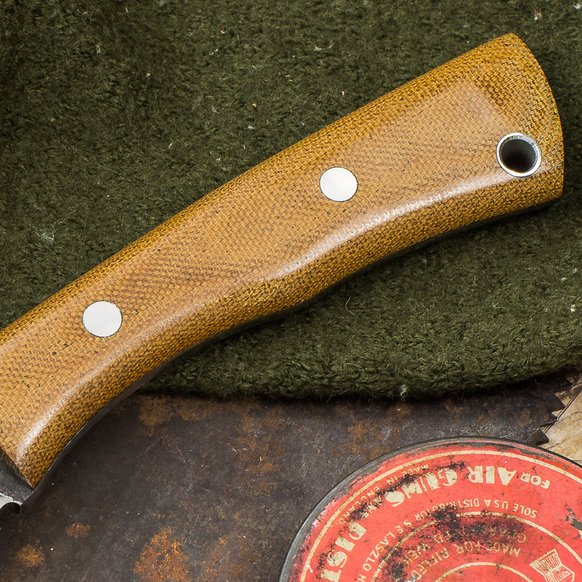FAQ: What are the advantages and disadvantages of different handle materials?
9th Jul 2015
When you're considering a particular knife, you look for quality. And while the blade is by far the most important component, the handle deserves attention as well.
If the handle is defective, cheap or poorly installed, it affects the overall value and utility of the knife. Then, beyond quality, it's a matter of choosing from the myriad handle materials available -- and that, we know, can be downright confusing.
We divide handle materials into two main categories: natural and synthetic. Natural materials -- like wood, bone, horn and antler -- are beautiful, traditional and time-tested as knife handles. Synthetic materials include Micarta, G-10, celluloid, various rubberized materials and acrylic.
Natural handle materials
In terms of aesthetics, most people will tell you that natural handle materials are their favorites. They also hold up quite well, generally speaking, and are an excellent choice.
The only drawback of natural handles is a tendency to expand and contract (gradually) with changes in temperature and humidity. On a full-tang knife that means you may occasionally feel the tang or the edge of a handle slab. It's nothing to worry about -- just give it a few days and it'll expand or contract back into place.
 Wood handles (including burls and spalted woods) are beautiful and durable. Their natural
expansion and contraction varies depending on the type of wood.
Wood handles (including burls and spalted woods) are beautiful and durable. Their natural
expansion and contraction varies depending on the type of wood.
Very oily woods -- like Desert Ironwood or African Blackwood -- are stable and solid. Other woods must be "stabilized" for sustained use on knives. (The stabilizing process involves filling the voids in the wood with a resin. The resin permeates the wood and makes it stronger.) Even stabilized wood can still expand and contract, but we believe it makes a fine knife handle.
Bone is most often used for the "scales" of pocketknives. It's popular because of its beauty as well as its ability to be dyed and "jigged" (carved). Most bone used in knife handles comes from cattle (shin bones, specifically), although camel bone is becoming more common these days. Bone-handled knives are a great choice.

Horn -- such as buffalo or impala horn -- is actually the hair of an animal. It's visually appealing, but it's prone to natural expansion and contraction and is less durable than most other natural materials. None of that makes it unsuitable for knife handles -- those are just the characteristics of horn knife handles.
Antler, contrary to what most people believe, is completely different from horn -- horn is hair, while antler is bone, making it much stronger and more stable than even the most durable wood.
The antler used for knife handles can come from elk or from deer, but the really good stuff comes from Indian Sambar Stag. Sambar has been banned for export from India for many years -- it's quite collectible now and its value is climbing every day. It's easily the most popular handle material in premium-quality traditional pocketknives and the favorite of many knife lovers (ourselves included).
Synthetic handle materials

Micarta and G-10 are similar. Both are resin-saturated substrates -- Micarta, originally developed as an insulator for electrical parts, uses cloth or paper as its substrate, while G-10 uses fiberglass.
Both Micarta and G-10 are available in a variety of colors, are completely stable and don't expand or contract. They look great, feel terrific in the hand and are nearly indestructible -- we highly recommend either Micarta or G-10 for hard-use knives.
Celluloid was a popular handle material during the mid-twentieth century, primarily on pocketknives. With its wide array of colors and patterns, its beauty is undeniable. Unfortunately, over time it degrades and tends to separate from the knife.
Even though we sell some pocketknives that still use this material, we can't give celluloid a high recommendation. According to most knife-appraisal books, a celluloid-handled knife is worth substantially less than a comparable knife handled in any other material.

Acrylic, on the other hand, offers all of the beauty of celluloid without the drawbacks. Its appearance is an acquired taste, and it isn't for everyone, but acrylic is a durable handle material for a quality pocketknife.
Injection-Molded Rubberized handles vary widely in their usability. If the rubber is too soft, it's almost certain to break down and be uncomfortable in real-world use. Honestly, most knife companies using rubberized handles do so for one reason -- to keep costs down.
There's one exception -- Fällkniven -- and we're proud to carry their knives. Fällkniven uses rubberized handles extensively and does a great job with them. Their handles are relatively hard, hold up well and feel good in the hand. Done well, it makes a fine knife handle.
Remember, if a blade is top-notch and the 'maker is using quality components, choose a handle material that you like and enjoy your knife.
